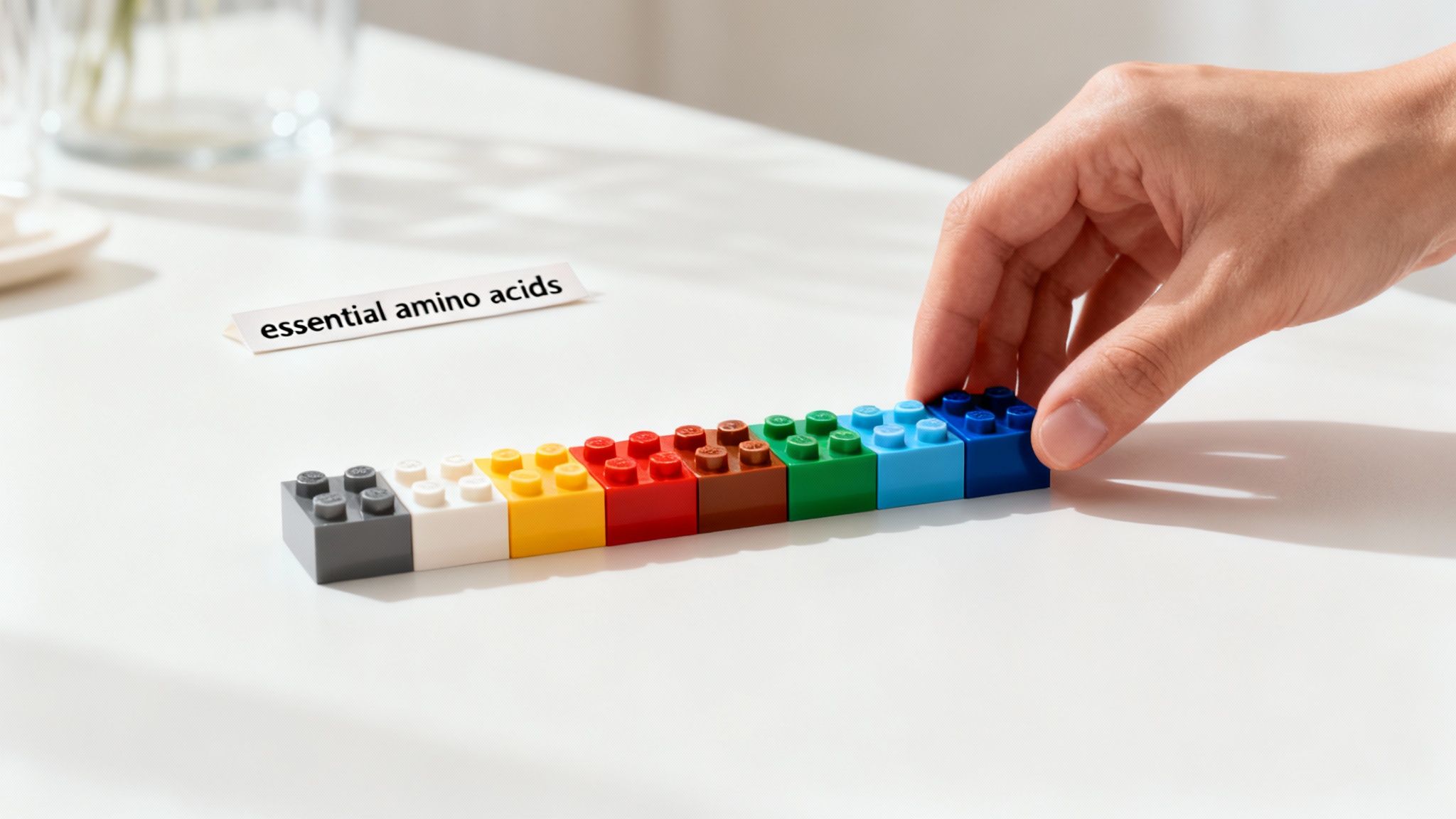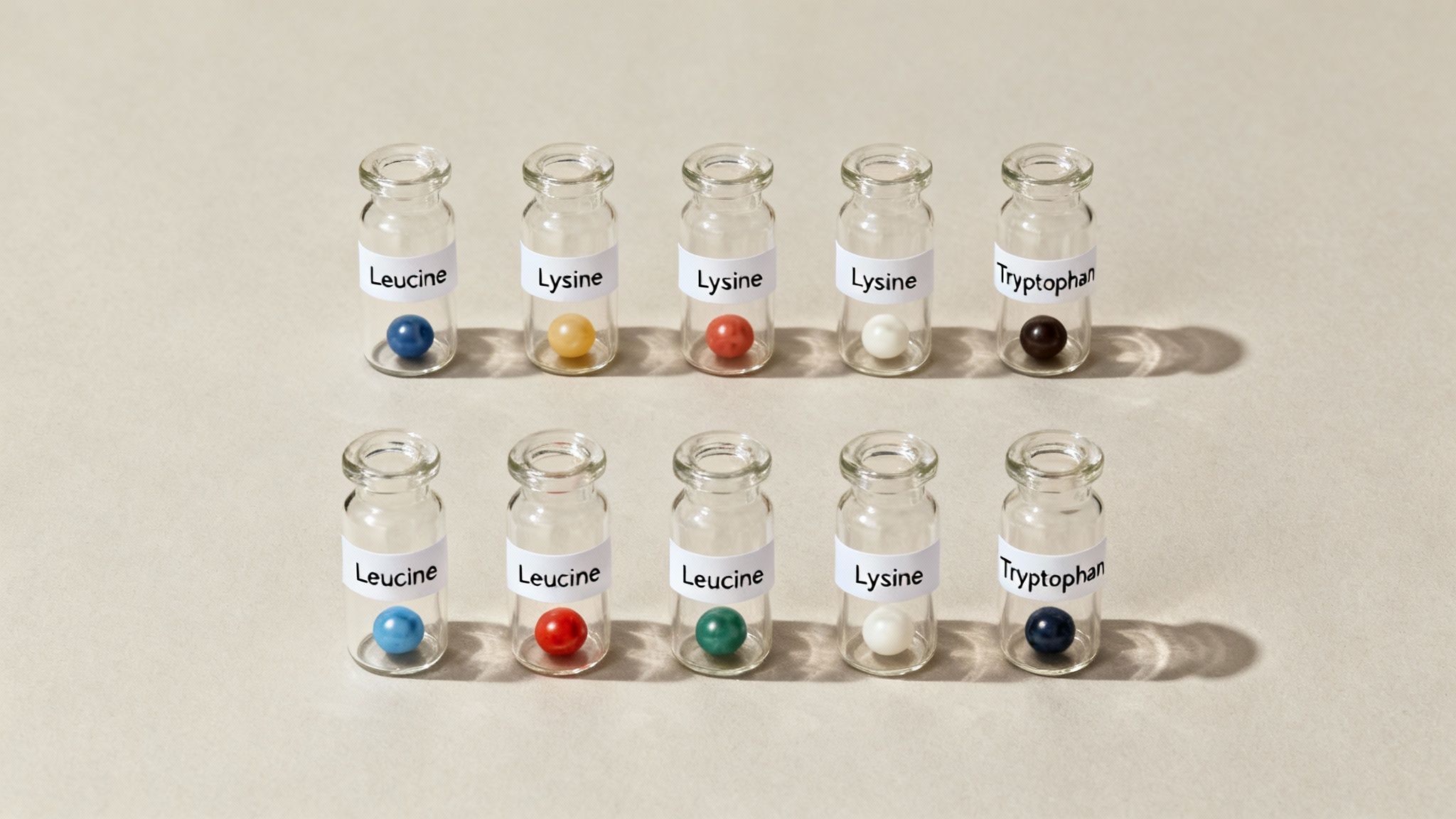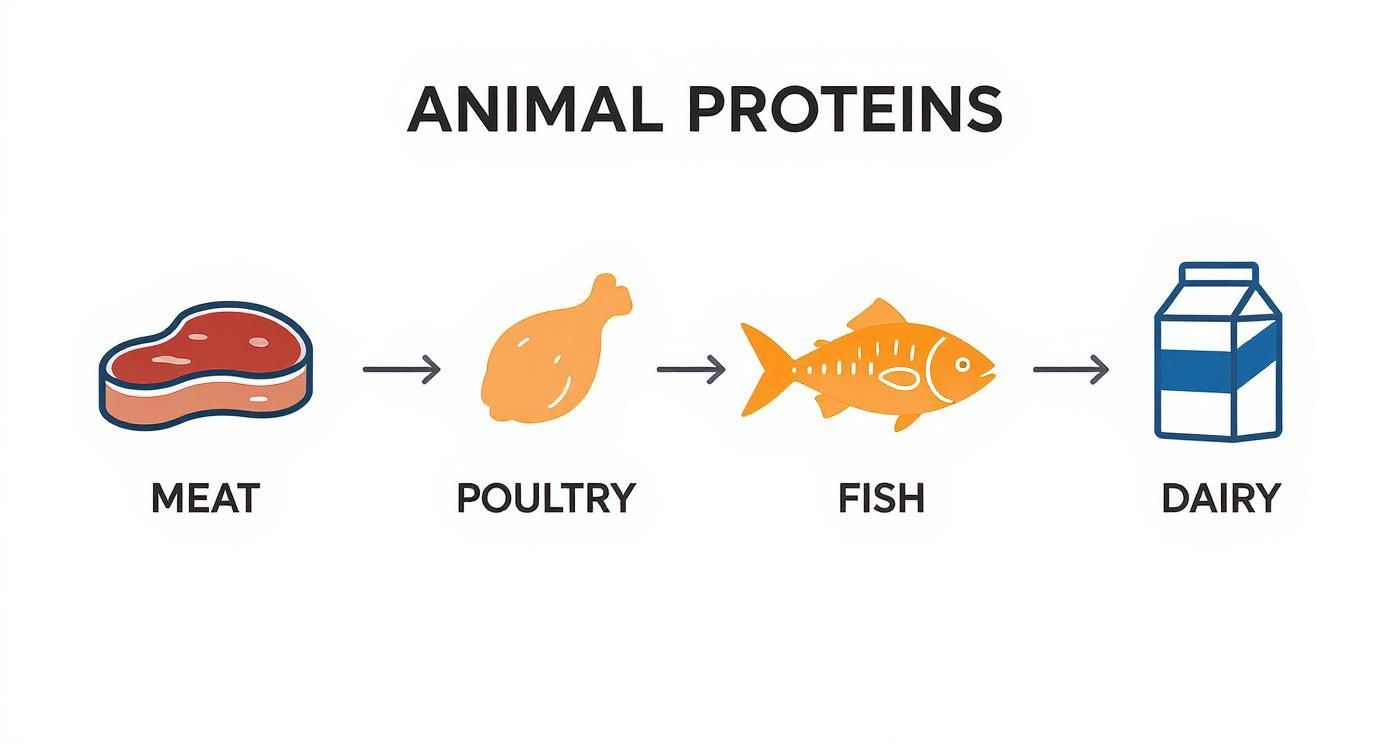What Makes a Complete Protein Your Ultimate Guide
Think of protein as the ultimate construction crew for your body. To get any job done—whether it’s repairing muscle after a workout, building new tissue, or even producing hormones—this crew needs a specific set of tools. Your body can make some of these tools on its own, but there are nine it simply can’t manufacture.
These are the essential amino acids, and you have to get them from food. A complete protein is any food source that provides all nine of these essential tools in one convenient package. Without them, the whole construction project grinds to a halt.
Your Body’s Most Essential Building Blocks

Let’s stick with the construction analogy. Imagine you’re building a house. You can source the wood, nails, and drywall locally—those are the non-essential amino acids your body makes. But the custom windows, specialized wiring, and unique fixtures have to be ordered from an outside supplier. Those are the essential amino acids.
A complete protein source is like getting a delivery that contains every single one of those specialized parts. When you eat one, you’re giving your body the full toolkit it needs to keep building and repairing everything from your muscles to your cells.
Why the Source Matters
This is where knowing the difference between protein sources really pays off. Generally, animal-based foods—we’re talking meat, fish, eggs, and dairy—are naturally complete proteins. They come with all nine essential amino acids ready to go.
On the other hand, most plant-based proteins are considered ‘incomplete,’ meaning they’re missing one or more of these crucial building blocks. That doesn’t make them bad, it just means you need to be a bit more strategic with your pairings.
To get the full picture of why this is so important, it’s worth understanding Muscle Protein Synthesis, which is the very process that puts these amino acids to work. It’s a fascinating look into how our bodies use protein, and it makes it clear that the quality of the protein you eat is just as important as the quantity.
Complete vs. Incomplete Protein at a Glance
To make this crystal clear, here’s a quick table breaking down the key differences.
| Protein Type | Essential Amino Acid Profile | Common Sources |
|---|---|---|
| Complete Protein | Contains all nine essential amino acids. | Meat, fish, poultry, eggs, dairy, quinoa, soy. |
| Incomplete Protein | Is missing one or more essential amino acids. | Most plant-based foods like beans, lentils, nuts, seeds, and grains. |
Think of this table as your cheat sheet. Complete proteins are the all-in-one solution, while incomplete proteins require a little mixing and matching to get the full set of tools your body needs.
Meet the Nine Essential Amino Acids

So, what exactly are these nine essential amino acids that make a protein “complete”? Think of them as a team of highly specialized workers on a construction site. Each one has a specific, non-negotiable job. If even one doesn’t show up, the whole project grinds to a halt.
These aren’t just names you skimmed in a science textbook; they are the microscopic drivers behind your everyday health. They have a direct say in how you feel, how your body recovers, and how you perform day in and day out.
Getting to know them helps drive home why having the full set is so important. Let’s skip the dry biochemistry lesson and instead connect these powerhouse molecules to real-world functions you can actually feel.
The Power Players of Protein
While all nine are critical, a few stand out for their well-known roles in fitness and wellness. For instance, leucine is basically the general contractor for muscle growth. It literally signals your body to kickstart the repair and building process after a workout.
Then you have tryptophan, which your body uses to create serotonin. You’ve probably heard of serotonin—it’s the neurotransmitter that helps regulate your mood, sleep, and even appetite. Skimp on tryptophan, and you might feel its effects on your rest and overall sense of balance.
And we can’t forget lysine. It’s vital for producing collagen (the protein that gives structure to your skin and bones) and plays a key part in helping your body absorb calcium.
Each essential amino acid has a distinct function, from building muscle and regulating mood to strengthening bones and supporting the immune system. A complete protein ensures no player is missing from the team.
The Complete Roster
Beyond those headliners, the other six members of this essential crew work tirelessly behind the scenes to keep your body running like a well-oiled machine.
Here’s a quick look at the full lineup and their roles:
- Histidine: Important for growth, tissue repair, and keeping your immune system sharp.
- Isoleucine: Helps with muscle metabolism and regulating your energy levels.
- Methionine: A key player in metabolism and your body’s natural detoxification processes.
- Phenylalanine: Used by your brain to produce important chemicals like dopamine.
- Threonine: Supports healthy skin and the connective tissues that hold you together.
- Valine: Works alongside leucine to aid in muscle growth and repair.
This team thrives on synergy. When all nine are present, your body can build, repair, and maintain itself without having to cut corners. That’s what makes a complete protein so fundamental to a healthy diet.
Where to Find Complete Proteins: Animal Sources
If you’re looking for the most direct, no-fuss way to get complete proteins, animal-based foods are your best bet. Think of them as the heavy hitters of the protein world—they naturally come pre-packaged with all nine essential amino acids your body needs to function at its best.
Every serving gives you the full deck of amino acid “cards,” making these foods incredibly efficient for everything from muscle repair to hormone production. It’s this built-in efficiency that makes them a cornerstone of so many balanced diets.
The Powerhouses of Protein
While almost any animal product will deliver the goods, a few standouts offer some extra nutritional perks that are worth talking about.
- Poultry and Lean Meats: Chicken, turkey, and lean cuts of beef are the classics for a reason. They pack a serious protein punch that’s essential for building muscle and keeping you feeling full longer. For a simple but incredibly satisfying meal, check out this recipe for grilled lemon-herb chicken with quinoa salad.
- Fish and Seafood: Salmon is a true superstar here. It’s not just a complete protein; it’s also loaded with anti-inflammatory omega-3 fatty acids, which are fantastic for your brain and heart health.
- Eggs and Dairy: Eggs are often called the “gold standard” of protein because of their incredible bioavailability. In simple terms, your body can absorb and use their amino acids with remarkable ease. Dairy options like Greek yogurt and cottage cheese are also excellent choices for a quick and substantial protein boost.
The global protein supply has been on the rise, climbing from around 85 grams per person per day in 2010 to over 90 grams by 2021. This growth is largely driven by the wider availability of complete animal proteins. You can find more insights on these global nutrition trends here.
Ultimately, mixing a variety of these animal sources into your diet is the best strategy. It ensures you’re consistently giving your body the high-quality building blocks it needs to thrive, and each source brings its own unique nutritional profile to the table for a well-rounded approach.
Building Complete Proteins From Plant-Based Foods
If you’re leaning into a more plant-forward diet, the whole “complete protein” thing might sound a little complicated. The good news? It’s really not. It’s more like a simple puzzle, and once you know the strategy, you’ll be a pro at fitting the pieces together.
Think of most plant foods as individual puzzle pieces. Each one has some, but not all, of the essential amino acids your body needs. The trick is simply combining different plant sources to create the full picture. We call this protein complementarity, and it’s way easier than it sounds.
The Power of Pairing
So many classic food combinations from around the world are naturally complete proteins. For example, legumes like beans and lentils are typically low in one amino acid (methionine) but high in another (lysine). Grains are the exact opposite—low in lysine but high in methionine.
Put them together in the same meal, and voilà! They perfectly complement each other’s amino acid profiles, giving your body the full set it needs to thrive.
You don’t need to hunt for one perfect plant food that has it all. The real magic is in creating smart, synergistic meals by combining different plant groups.
For context, this is why animal-based foods are often called “complete” on their own—they come with all nine essential amino acids already packaged together, no pairing required.

This just shows how different food groups bring different strengths to the table.
Plant-Based Superstars and Classic Combos
Some incredible plants are actually complete proteins all by themselves. Think of these as your go-to options for a quick, powerful protein boost.
- Quinoa: This versatile grain is a powerhouse. It works beautifully in salads, grain bowls, or as a simple side dish.
- Soy Products: Tofu, tempeh, and edamame are all fantastic sources that pack a serious protein punch.
- Chia Seeds: These tiny seeds are perfect for adding to smoothies, oatmeal, or making a delicious pudding.
For all the other amazing plant foods out there, pairing is the key. You’re probably already eating these classic combos without even realizing they form complete proteins.
To give you some ideas, we’ve put together a table of tried-and-true pairings that chefs and home cooks have relied on for generations.
Classic Plant-Based Protein Pairings
| Food Group 1 (e.g., Legumes) | Food Group 2 (e.g., Grains) | Example Meal |
|---|---|---|
| Beans | Rice | A classic burrito bowl or red beans & rice |
| Lentils | Barley | Hearty lentil and barley soup |
| Chickpeas | Wheat | Hummus with whole-wheat pita bread |
| Peanuts (a legume!) | Whole-Wheat | Peanut butter on whole-wheat toast |
As you can see, creating complete proteins is often simple and intuitive. It’s all about mixing and matching to cover all your nutritional bases.
While animal products still lead the global protein market, the shift toward plant-based eating is undeniable. The plant-based meat market alone was valued at around $10 billion by 2024, which points to a huge change in how people are eating. If you’re looking for chef-driven plant-based meals in Atlanta, exploring the services of a vegan or vegetarian private chef can be an incredible source of inspiration and convenience.
Why Complete Proteins Fuel Your Overall Health
It’s one thing to know what a complete protein is, but it’s another thing entirely to connect that knowledge to your daily well-being. That’s where the magic really happens.
Think of complete proteins as more than just food—they’re the fundamental building blocks for nearly every system in your body. Every time you eat one, you’re making a direct investment in your long-term health, with benefits you can actually see and feel.
Muscle Repair and Beyond
For anyone who’s active, from dedicated athletes to weekend joggers, complete proteins are non-negotiable. Physical activity creates tiny microscopic tears in your muscle fibers. Complete proteins deliver the full set of nine essential amino acids needed to patch them up, making them stronger than before. Without this complete toolkit, recovery drags on and your progress can stall out.
But the benefits go far beyond the gym. Your immune system is another area that desperately needs these proteins. The antibodies that patrol your body, hunting down and neutralizing invaders like bacteria and viruses, are literally made from protein.
Eating enough complete protein ensures your body has the raw materials to keep its defense system strong and responsive, helping you stay healthier all year long.
A strong immune response, efficient muscle recovery, and balanced hormones all have one thing in common: they depend on a steady supply of all nine essential amino acids from complete protein sources.
On top of that, complete proteins are critical for producing the hormones that act as your body’s messengers. These tiny molecules control everything from your metabolism and energy levels to your mood and sleep cycles. A diet rich in complete proteins helps support hormonal balance, leading to a more stable and energized you.
This is a core principle behind many wellness strategies, including the ones we explore in guides to what clean eating is. Prioritizing high-quality, whole-food protein sources is a simple but incredibly powerful way to support your body’s complex internal machinery. It’s how you turn a nutritional concept into an empowering health strategy, fueling your body for peak performance every single day.
Your Questions on Complete Protein Answered
Even after getting the hang of complete proteins, a few practical questions always seem to pop up. This is where we cut through the noise and tackle the most common queries, giving you clear, straightforward answers you can actually use.
Think of this as your go-to guide for putting protein knowledge into practice. We’ll clear up any lingering confusion and help you feel confident about your choices.
Do I Need a Complete Protein at Every Single Meal?
Not at all. Your body is incredibly resourceful and keeps a handy little “pool” of amino acids to pull from all day long. The real goal isn’t to cram all nine essential amino acids into every meal. It’s about getting enough of each one over the course of a 24-hour period.
For instance, if you have rice (which is low in lysine) for lunch and some beans (high in lysine) for dinner, your body knows exactly what to do. It combines them perfectly. It’s the daily total that truly matters.
Are Protein Powders a Good Source?
Many of them are, but it all comes down to the source. Powders made from whey and casein—both dairy derivatives—are naturally complete proteins. Today’s plant-based powders are also getting smarter; they’re often formulated by blending different sources, like pea and rice protein, to build a full amino acid profile.
When you’re picking a protein powder, always flip it over and check the nutrition label. Look for a statement confirming it has a complete amino acid profile to make sure you’re getting the good stuff.
So, How Much Complete Protein Do I Actually Need?
This is the big question, and the answer is: it depends. The general rule of thumb for a sedentary adult is around 0.8 grams of protein per kilogram of body weight. But that number can jump quite a bit depending on your lifestyle.
Your protein needs are higher if you are:
- Highly Active: Athletes and anyone who exercises regularly needs more protein to repair and build muscle.
- Aging: As we get older, a little extra protein helps prevent the natural muscle loss that comes with age.
- Pregnant or Breastfeeding: Protein needs go up to support the baby’s growth and development.
If you’re an active person, you might want to dig deeper into guides on topics like how much protein endurance athletes really need to optimize performance and recovery. For truly personalized advice, though, nothing beats a chat with a registered dietitian.
Is It Possible to Eat Too Much Protein?
For most healthy people, a high-protein diet is generally safe. The catch? Pushing it to extremes for a long time can put extra strain on the kidneys, especially if you have a pre-existing kidney condition.
Like with anything in nutrition, balance is everything. The smartest strategy for long-term health is to prioritize whole-food protein sources over the highly processed stuff.
At Culinary Collective Atl, we create personalized menus that align with your unique health goals and dietary needs, making it easy to enjoy delicious, chef-crafted meals rich in high-quality protein. Discover how our private chef services can transform your dining experience by visiting https://www.theculinarycollectiveatl.com.





